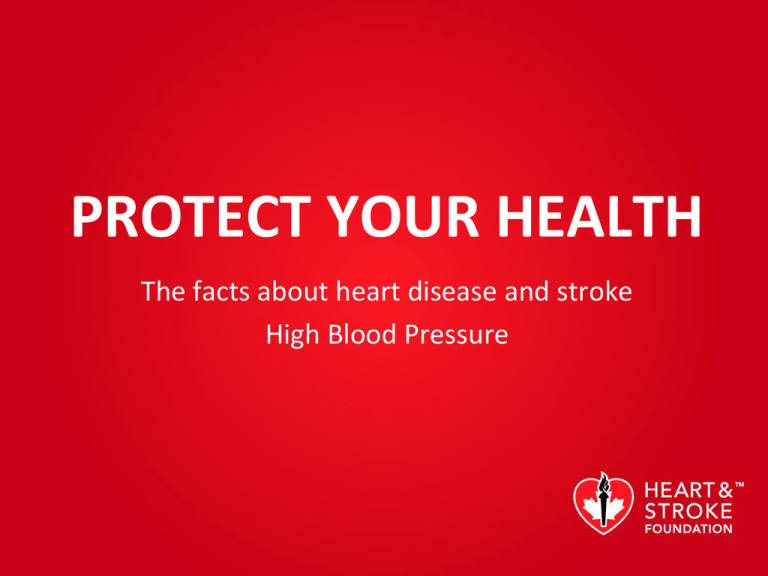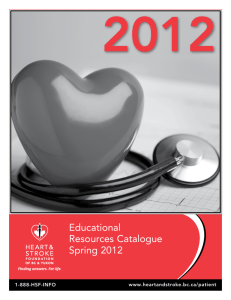
PROTECT YOUR HEALTH
The facts about heart disease and stroke
High Blood Pressure
Millions of Canadians at risk of
cardiovascular disease
Over 4.7 million people still smoke
Over 60% of Canadians are above a healthy weight
19% have high blood pressure
“Ninety percent of Canadians have at least one risk
factor for cardiovascular disease – which makes it
more important than ever for the Heart and Stroke
Foundation to support research into the root causes
of the heart disease risk factors AND discovery of
successful strategies to prevent the development of
these risk factors.”
Heart and Stroke Foundation Researcher
Dr. Sonia Anand MD PhD FRCPc
Professor of Medicine, McMaster University
Topics for today
How the heart works
Warning signs of heart attack
How the brain works
Warning signs of stroke
Risk factors, high blood pressure
What the Heart and Stroke
Foundation is doing
How the Heart Works
The heart
Is a muscle the size of a clenched fist
Is located behind the breastbone
Pumps about 100,000 times a day
Pumps about 7,600 litres of blood per day
Anatomy of the heart
Atherosclerosis
Plaque
Heart attacks
Blood flow through coronary arteries is blocked
Vital blood supply to heart muscle is cut off
About 70,000 heart attacks each year
Victims can often recover if treated immediately
Warning signs of a heart attack
Chest discomfort (uncomfortable chest
pressure, squeezing, fullness or pain,
burning or heaviness)
Discomfort in other areas of the upper
body (neck, jaw, shoulders, arms, back)
Warning signs of a heart attack
Shortness of breath
Sweating
Nausea
Light-headedness
Warning signs of a heart attack
If you are experiencing any of the warning signs of a
heart attack ….
Call 9-1-1 or your local emergency number
IMMEDIATELY
Stop all activity
Take your normal dose of nitroglycerin (if
prescribed)
If you are experiencing chest pain, take one dose of
160-325mg of ASA.
Rest until the EMS arrive
Cardiopulmonary resuscitation (CPR)
Most important factor in reducing pre-hospital
deaths from cardiac arrest
CPR courses teach lifesaving skills
The Heart and Stroke Foundation collaborated on
Resuscitation Guidelines in the US and Canada
“It only takes a few minutes to save a life.
CPR and defibrillation if administered early
can triple or quadruple a person’s chance
of survival.”
Heart and Stroke Foundation researcher
Ian G. Stiell, MD, MSc, FRCPC
Professor and Chair, Department of Emergency Medicine,
University of Ottawa
Distinguished Professor and University Health Research Chair,
University of Ottawa
Automated external defibrillator (AED)
Automatically analyses heart rhythm
Delivers controlled shock if needed to restore
normal heart rhythm
Now found in public places such as sports arenas
and airports
For course information, please call
1-888-HSF-INFO
How the Brain Works
The brain
A stroke is…
An injury to a part of the brain caused by
interruption of blood flow
“Research has shown us that when blood flow is
reduced, the brain tries to protect itself by releasing
certain chemicals. In the short term, these chemicals
can be protective but if blood flow is not restored
quickly, they can actually contribute to brain damage.
These insights have opened up new possibilities for
developing drugs to protect the brain—agents that
we call neuroprotectives.”
Heart and Stroke Foundation Researcher
Yu Tian Wang, PhD
Heart and Stroke Foundation of British Columbia and
Yukon Chair in Stroke Research
Professor, Department of Medicine, University of British Columbia
Ischemic strokes
Hemorrhagic strokes
Warning signs of a stroke
Stroke can be treated. That’s why its so important to recognize
and respond to the warning signs.
Weakness - Sudden loss of strength or sudden
numbness in the face, arm or leg, even if
temporary
Trouble speaking – Sudden difficulty speaking
or understanding or sudden confusion, even if
temporary
Vision problems – Sudden trouble with vision,
even if temporary
Warning signs of a stroke
Headache – Sudden severe and unusual
headache
Dizziness – Sudden loss of balance,
especially with any of the above signs
React immediately
If you experience any of these symptoms, Call 9-1-1
or your local emergency number IMMEDIATELY
Risk Factors for
Heart Disease
and Stroke
Risk factors you can’t control
Age
Gender
Family history
Ethnicity
Prior stroke or TIA
What you can do to lower your risk
Know and control your blood pressure
Know and control your blood cholesterol
Manage your diabetes
Maintain a healthy weight
Eat a healthy diet
Limit alcohol consumption
Be physically active
Be smoke-free
Reduce stress
Know and control your high blood pressure
High blood pressure has no visible symptoms
Should be checked at least every two years by
a healthcare professional
Visit heartandstroke.ca/bp
What is high blood pressure
“Blood pressure measures how
hard blood pushes against the
blood vessel walls.”
Copyright 1996 Tim Peters and Company, Inc. All rights
reserved.
Blood pressure has TWO numbers
Top number = pressure when heart contracts
(systolic)
Bottom number = pressure when heart relaxes
(diastolic)
Example: healthy BP = 120
80
Classifications of hypertension
Category
Optimal
High blood pressure
High normal
Canadian Hypertension Education Program (CHEP), 2012
Systolic
Diastolic
<120-129
<80-85 mm Hg
140
90 mm Hg or higher
130-139
80-89 mm Hg or higher
High blood pressure can:
Increase risk of stroke
Increase risk of heart disease
Damage kidneys and eyes
Cause impotence
Disrupt circulation
Risk factors you can’t change
Age
Family history
Ethnic background
South Asian
Aboriginal Peoples
People of African Descent
Risk factors you can change
Take your blood pressure medication as prescribed
Understand and monitor your blood pressure
Be smoke-free
Maintain a healthy weight
Maintain a balanced diet
Get active
Limit alcohol intake
Manage stress
How often should I check
my blood pressure?
Category
Frequency
Optimal
At least every two years by a
healthcare provider
130-139
85-89
Every year or as recommended by
your doctor
Above 139
89
Check often – your doctor will tell
you just how often
If using a home blood pressure monitor:
Ask doctor’s advice
Record results and show to doctor
Select monitor endorsed
by Hypertension Canada
Ensure correct cuff size
Check monitor for accuracy
Learn and use proper measurement
technique
“White coat hypertension”
A few people have high blood pressure when they visit the
doctor’s office but have normal blood pressure when they
go about their usual daily activities.
Regular monitoring is required, as many people with WCH
may develop high blood pressure over time.
Preparing to take your blood pressure:
Wait 2 hours after a big meal or heavy exercise
Wait 30 minutes after exercising, smoking or drinking caffeine
Don’t measure if you are in pain or upset
Be in calm warm environment
Empty your bladder or bowel
Sit quietly with your arm and back supported for 5 minutes
prior
When taking your blood pressure:
Do not speak
Be seated
Keep back supported
Keep legs uncrossed
Keep feet flat on the floor
Ensure arm is supported
Place cuff on bare arm,
3 cm above fold of elbow,
at heart level
Know and control your blood cholesterol
Ask your doctor if you are at risk and should
be tested
Can be lowered by reducing your fat intake and
being physically active
May be controlled with medication
Manage your diabetes
Damages blood vessels, causes circulation problems
Reduce risk of diabetes by healthy diet, activity,
weight control
Control diabetes to reduce your risk of heart
disease and stroke
Maintain a healthy weight
Achieve and maintain a healthy body weight by
enjoying regular physical activity and healthy eating
Small weight loss can significantly reduce risk
Visit heartandstroke.ca/healthyliving
“With over 60% of Canadians being over-weight or
obese, we are faced with a serious public health
problem.”
Heart and Stroke Foundation Researcher
Bruce A. Reeder MD, MHSc, FRCPC
Department of Community Health and Epidemiology
University of Saskatchewan
Eat a balanced healthy diet
Enjoy a variety of foods from the four food groups
Choose lower fat dairy products, leaner meats and
watch your portion size
Find delicious recipes and helpful cooking tips at
heartandstroke.ca/recipes
Reduce dietary salt
Choose fresh foods
Prepare home cooked meals
Season foods with herbs, salt-free spices, lemon, vinegar,
garlic and onion
Limit intake of salty condiments
Avoid salty processed foods
Look for products with the Health Check™
symbol
Limit alcohol consumption
Women—no more than 2 drinks/day to a maximum
of 10 drinks/week
Men—no more than 3 drinks/day to a maximum of
15 drinks/week
These guidelines do not apply if you are driving a vehicle,
taking medications or other drugs that interact with alcohol,
pregnant or are trying to get pregnant or breastfeeding,
making important decisions, doing any kind of dangerous physical
activity, living with alcohol dependence or mental or physical
health problems, or responsible for the safety of others. I
f you are concerned about how drinking may affect your health,
talk to your doctor
Be physically active
Adults aged 18-64 should accumulate at least
150 minutes of moderate-to-vigorous intensity
aerobic physical activity per week in bouts of
10 minutes or more
Be active most days of the week
Consult a healthcare professional
before starting an activity program
Be smoke-free
Smoking cessation programs improve the
chances of quitting
Visit heartandstroke.ca for tips on
quitting successfully
“After you quit smoking, your risk of heart attack
begins to decrease within just two days. Within a
year it’s cut in half. And within 10 to 15 years, your
risk of heart disease is almost the same as a
non-smoker’s.”
Heart and Stroke Foundation researcher
Paul W. McDonald, PHD
Professor and Chair, Health Studies and Gerontology
University of Waterloo
Reduce stress
Recognize sources of stress
Consider relaxation exercises
Ask for help from family, friends, or a
healthcare professional
What the
Heart and Stroke
Foundation is doing
The Heart and Stroke Foundation
at work in your community
World class research
Advocating for social change
CPR/AEDs
Promoting healthy living
Interested in volunteering?
Visit heartandstroke.ca
Call 1-888-HSF-INFO
Contact your local area office
Visit heartandstroke.ca and sign up today!
What can YOU do?
Learn about your risk factors and how to reduce
their impact
Know the warning signs of heart disease and stroke
and what to do
Learn CPR
Become a volunteer
Sign up for He@lthline
Visit heartandstroke.ca
Thank you!









